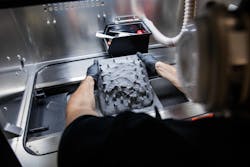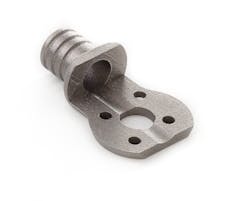People often contact me because they want to 3D print a replacement part. The requests have been as mundane as a stove knob or as novel as a replacement crystal for a chandelier. Typically, they are trying to source rare automotive parts. Others request parts for antiques or niche industrial equipment. Regardless of the application, the approach to a replacement printed part is largely the same.
Before pursuing 3D printing a replacement part, I always recommend first exhausting all of your sourcing options. If a part can still be ordered from a vendor, it is very rare for it to make economic sense to 3D print it. Depending on the part, there may be a forum online or a junkyard to source a replacement.
However, some parts are truly “unobtanium,” a fun term restorers use for parts that truly cannot be sourced. There is some investment involved in getting a replacement 3D-printed part, so these parts are of high value. These will usually be parts that, if broken or missing, will render an expensive piece of equipment or vehicle non-functioning and useless.
Creating a CAD Model: the Key to Replacing Rare Parts
The first and largest hurdle to 3D printing a replacement part is getting a 3D CAD of the part to accurately describe the part’s geometry. In rare circumstances, you may get lucky and find such a file on the internet or find a technical drawing identifying the dimensions. For a simple part you could recreate the design by taking careful measurements with calipers, but often for more complex or organic parts, the part will need to be 3D scanned. This process can cost a few hundred dollars with a company that offers a professional service. Increasingly, there are solutions to 3D scan using smartphones, but the results are quite inaccurate.
The 3D scan data may require some additional work to get it a clean, 3D-printable file. An STL file can be used for 3D printing, but STP files are better because they can be used for a myriad of other manufacturing processes outside of 3D printing. Even with a professional scan, it is important to understand what the critical dimensions of the part are to ensure functionality and a proper fit—and then double-check them with calipers to determine if the 3D CAD accurately captured the part details. The last thing you want is to spend money on a part with critical dimensions that simply don’t work in the assembly.
The Difficulties of Recreating Parts
If the part being replaced is damaged or nonexistent you have a real challenge. On many vehicle components there is a left-side and right-side variant of the part. If one side is damaged and the other is not, it may make sense to reverse engineer the non-damaged side and the design can simply be mirrored once translated to 3D CAD. Be aware, though, that reverse engineering damaged parts comes with some risks, and you may have to go through a few iterations to get a proper fit.
Once the 3D CAD is created, you can 3D print the replacement part. If the component is plastic, there are many available plastic printing processes, each with their own pros and cons. It is important to consider the type of plastic in which the original part was made and what sort of environmental forces are put on the part during its lifetime. Does the part see high heat? Is it exposed to chemicals such as gasoline or brake fluid? Is it commonly exposed to sunlight? Parts with specific material requirements will often drive the decision about which 3D printing process to use to replicate the part.
Available Production Methods
FDM (Fused Deposition Modeling) is the most common technology for desktop 3D printers and will nearly always be the cheapest option. The tradeoff is the part will have distinct layer lines and the parts may be weak along the print layers. This can cause them to delaminate and break along the layer lines when pushed beyond their limits. The printing process also requires a scaffold-like support structure, which can limit printable geometries.
FDM has a very wide range of available materials. If a part needs to be made in a specific plastic, FDM may be the way to go. For parts with low cosmetic and low strength requirements (such as the aforementioned stove knob), this will be the best process.
SLS (Selective Laser Sintering) and MJF (Multi Jet Fusion) are similar processes that both create parts by sintering plastic powder. These are the most common 3D printing processes for creating end-use plastic parts. Parts made in this process are typically stronger than those made via FDM and the finish is textured but also more consistent than FDM. Aesthetically, they do not have that course 3D-printed look that you often see on FDM parts. These processes do not use support structures, and each offers more design freedom than FDM.
The material options are more limited than FDM, but SLS/MJF have several common production plastics such as polyamides (aka nylon), polypropylene and TPU (thermoplastic urethane). You can choose to use vapor smoothing to improve the surface finish and make it glossier and smoother, helping the part mimic the finish of injection molding, which is by far the most common manufacturing method for production plastic parts. These technologies also scale well at higher volumes. If multiple copies are needed these options are worth considering.
SLA (Stereolithography) and other light curing processes are rarely used for replacement parts but are worth mentioning for more niche applications. Most materials made with these processes are light sensitive and will discolor and become more brittle with exposure to sources of UV light (like the sun). Light sensitivity is the main reason this process is not commonly used for replacements. However, this limitation can be overcome by coating the part in paint, clear coat or plating.
SLA processes can offer very clear material options, making it worth considering when a clear part is needed. Capable of very high resolution, SLA is also the best choice for parts with small features.
Urethane casting is often used in conjunction with 3D printing to produce replacement parts. A copy of the part is 3D printed and used to produce the mold for urethane casting. Alternatively, 3D printing can be used to create the mold itself into which urethane can be poured. This is a labor-intensive process, but it can create a very high-quality replacement. Also, urethane casting offers a wide range of robust plastic-like and elastomeric material options.
DMLS (Direct Metal Laser Sintering) is a 3D printing process that uses a laser to selectively melt metal powder to 3D-print parts out of metal. Although DMLS printing creates metal replacement parts, it’s expensive, so the viable use cases are more niche. For example, you could use DMLS to manufacture parts for exceptionally rare and expensive vehicles, such as a World War II-era fighter plane or an early 20th Century steam-powered car.
Because the printing process builds parts up from sintered powder, the printed parts naturally have a textured finish. Interestingly, the finish is quite similar to cast metal parts. Casting metal was (and still is) a very common manufacturing method for creating many metal parts. The finish and appearance of the printed metal replacements often naturally resembles the finish of the original part. Like casting, the printing process has a tolerance of a few thousandths of an inch, meaning for precision fits the parts may need secondary machining. It is not uncommon to have to do secondary machining such as tapping threads or machining a mating face flat.
READ MORE: Access to Automation: Apps, Metaverse and Cobots at Low Cost
Improving Old Parts with 3D Printing
Beyond straightforward replacement parts, 3D printing can be used to create novel improvements and adaptations of existing or past designs. Capturing the design in a 3D CAD before printing gives you a window of opportunity to improve, modernize, or customize the design. If faithful reproduction is not the goal, then why not improve?
3D printing can be used to satisfy demand for low volumes of custom parts that may be lighter or personalized. For many industries, there is a small segment of the market willing to pay more for a custom version of the product, and 3D printing gives an avenue to explore and satisfy that market demand. For example, 3D printing is used in racing applications for virtually every vehicle imaginable, from boats to bicycles, where a select few are looking for the lightest parts possible. For aircraft and nautical vehicles, reducing weight can result in significant weight savings that increase range.
Eric Utley is a technical sales engineer with Protolabs.
About the Author

Eric Utley
Applications Engineer
Eric Utley has more than 16 years of experience in rapid prototyping and additive manufacturing. His focus is on stereolithography, selective laser sintering and direct metal laser sintering technologies, and he provides guidance to engineers on designing for manufacturability. Utley regularly consults with product development professionals from a range of industries including medical, consumer products, aerospace and automotive. He earned a bachelor’s degree from North Carolina State University.



